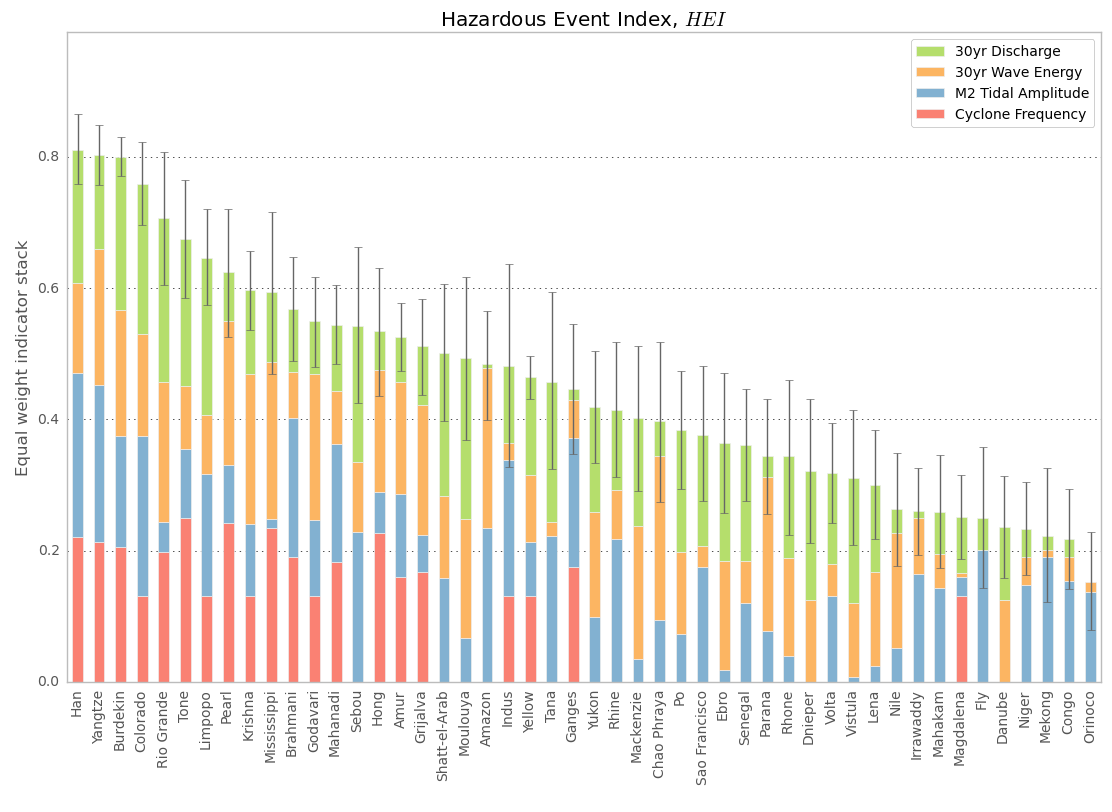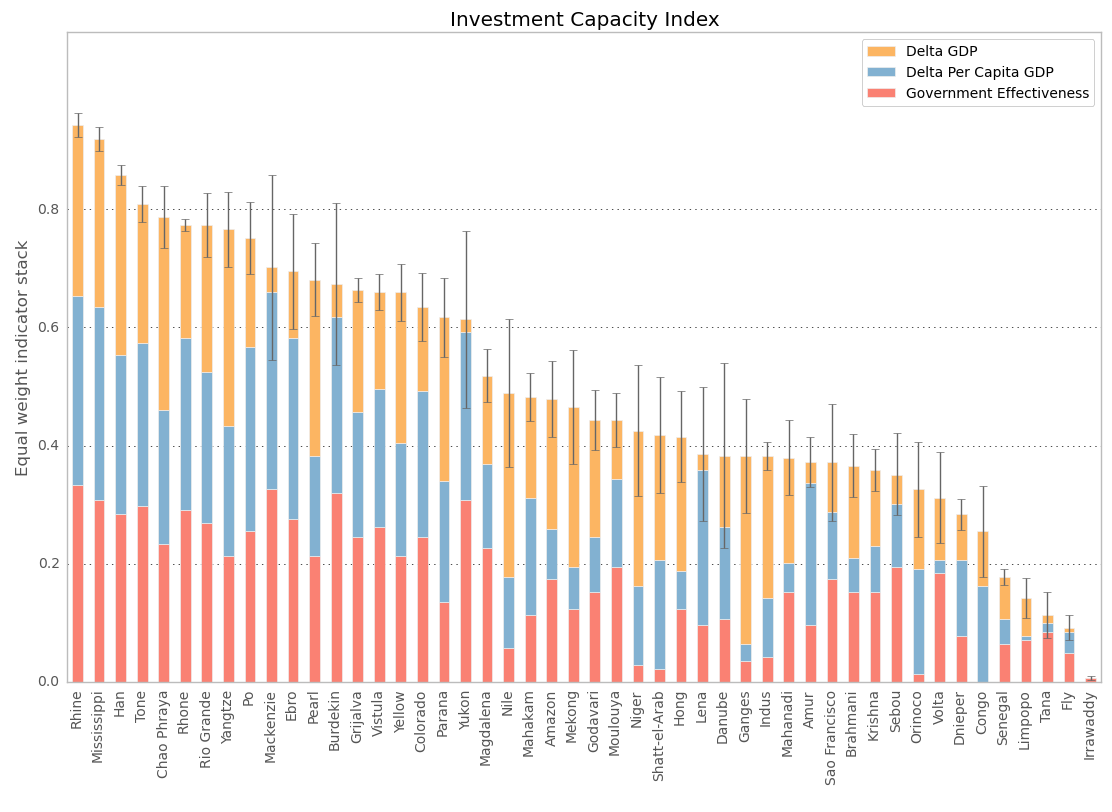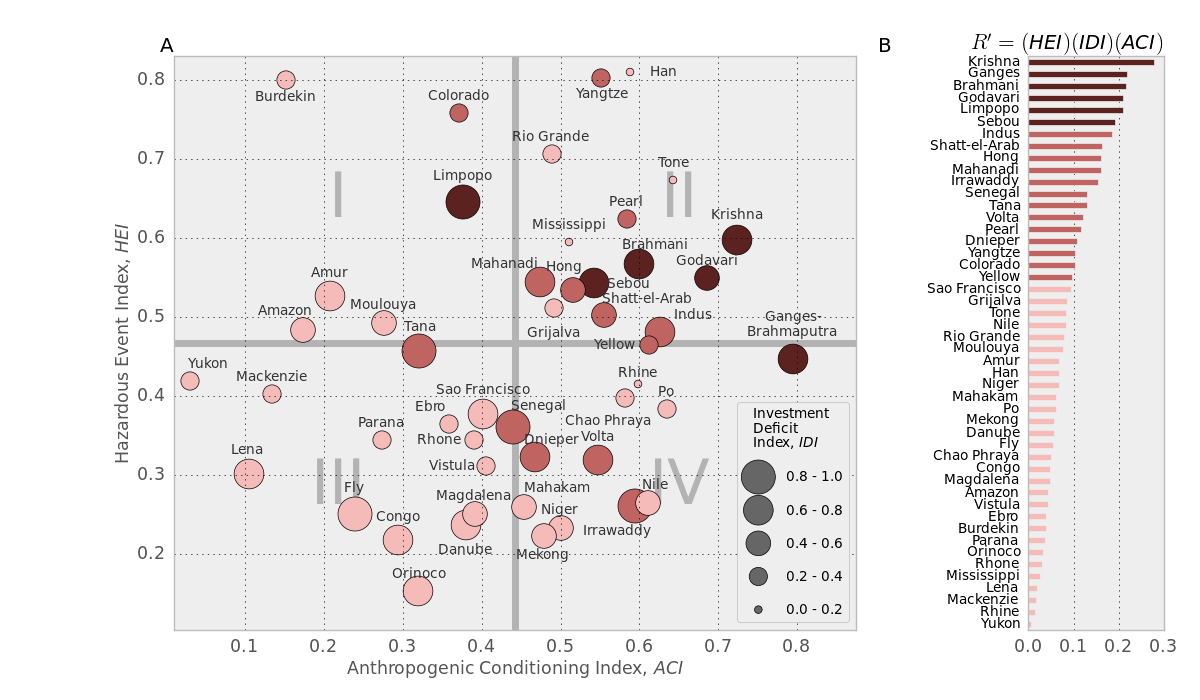RATIONALE FOR STUDY:
The need to understand and forecast the rapidly changing state of these linked geophysical-social systems serves as the chief impetus for this study. While the many challenges are well-documented for specific delta systems and specific issues, there is a need for more systematic approaches to the study of risk to both the natural and human components of these systems. This study is an initial attempt at formulating such an integrated global view.
PRECURSOR STUDIES:
We build on a sequence of earlier scientific and policy studies by the study team, beginning with an early exposition by Ericson et al. (2006)1 that documented the pandemic nature of delta vulnerability and positioned its predominant sources on the landmass (trapping of watershed river sediment by artificial reservoirs plus land management and engineering on deltas locally). More comprehensive assessments were executed, which included updated global synthesis and analysis of upland drivers of change2-5, focused case studies6,7, improved analytical tool8,, policy implications an outreach10-12.
It was clear from these studies that deltas owe their current and future condition to a complex amalgam of both natural and human processes, well beyond the issue of sea level rise alone. The current study takes these concepts and embeds them within a new risk assessment framework to evaluate the contemporary state and future trajectories of deltas across the globe.
RISK FRAMEWORK
Risk is estimated utilizing an expected loss model with three risk components. Hazard (H) is the probability of a hazardous event of a particular intensity occuring in a delta. Exposure, E is the expected number of people exposed to hazardous conditions as a result of that event. Finally, vulnerability, (V) is the harm or loss experienced by those people who are exposed. Measuring these terms for any given delta is non-trivial, as the probability distribution of all hazardous events h is not well known. $$ R = \sum_h {HEV} $$ We also note that relative sea-level rise (RSLR) has the effect of increasing exposure, as it brings more people to lower elevations and into potential flood zones. We use this point to define the rate of change of risk due to sea-level rise as $$ R' = \sum_h {HE'V} $$
In this paper, we developed a method to estimate these terms based on globally available empirical data sets. The use of global data allows for consistent comparision across all deltas. Each term is estimated utilizing a suite of indicators derived from global remote sensing or models:
Hazardous Event Index (HEI) - Proxy for Hazard, H
- Tropical Cyclone Frequency and Intensity Index
- Extreme river discharge, 30 yr return level
- Extreme wave energy, 30 yr return level
- M2 Tidal Amplitude

Anthropogenic Conditioning Index (ACI) - Proxy for rate of change of Exposure, E'
- Sea-level rise trend
- Oil and Gas Extraction
- Delta Groundwater Depletion
- Delta Impervious Surfaces
- Basin Impervious Surfaces
- Delta Wetland Disconnectivity
- Basin Wetland Disconnectivity
- Delta Population Density
- Basin Population Density
- Basin Reservoir Trapping

Investment Deficit Index (IDI) - Proxy for Vulnerability, V
- Delta Aggregate GDP
- Delta Per-Capita GDP
- Government Effectiveness

RISK SPACE
Together, these three indexes define a delta risk space. The figure below shows contemporary estimates of delta risk factors, and how greatly risk is increasing due to relative sea-level rise. However, these risk factors are not expected to remain static. We examine risk sensitivity to changes in vulnerability, or the capacity for a delta to reduce risk through investments in coastal infrastructure. Based on future economic growth and energy price forecasts by the US Energy Information Administration, we estimate the impact on risk that would follow a decrease in investment in protective infrastructure. We find that certain wealthy deltas, in particular the Mississippi and Rhine, would be exposed to substantially greater risks due to RSLR in this future scenario.

REFERENCES
- Ericson, J. P., Vörösmarty, C. J., Dingman, S. L., Ward, L. G. & Meybeck, M. (2006). Effective sea-level rise and deltas: causes of change and human dimension implications. Global and Planetary Change 50: 63–82.
- Syvitski, J.P.M. and J.D. Milliman (2007). Geology, geography, and humans battle for dominance over the delivery of fluvial sediment to the coastal ocean. J. Geology 115: 1-19.
- Syvitski, J. P. M. (2008). Deltas at risk. Sustainability Science 3: 23–32.
- Syvitski, J.P.M., A.J. Kettner, M.T. Hannon, E.W.H. Hutton, I. Overeem, G.R. Brakenridge, J. Day, C. Vörösmarty, Y. Saito, L. Giosan, and R.J. Nicholls (2009). Sinking deltas due to human activities. Nature Geoscience 2: 681-686.
- Cohen, S., A.J. Kettner, and J.P.M. Syvitski (2014). Global suspended sediment and water discharge dynamics between 1960 and 2010: Continental trends and intra-basin sensitivity. Global and Planetary Change 115: 44-58.
- Higgins, S., Overeem, I., Tanaka, A. & Syvitski, J. P. M. Land subsidence at aquaculture facilities in the Yellow River delta, China. Geophys. Res. Lett. 40, 3898–3902 (2013).
- Higgins, S. A., Overeem, I., Steckler, M.S., Syvitski, J.P.M., Seeber, L., and Akhter, S.H. InSAR measurements of compaction and subsidence in the Ganges-Brahmaputra Delta, Bangladesh, J. Geophys. Res. Earth Surf., 119, 1768–1781, doi:10.1002/2014JF003117, (2014).
- Kettner, A.J. and J.P.M. Syvitski (2008). HydroTrend v3.0: A climate-driven hydrological transport model that simulates discharge and sediment load leaving a river system. Computers and Geosciences 34: 1170-1183.
- Cohen, S., A.J. Kettner, J.P.M. Syvitski, and B.M. Fekete. (2013). WBMsed, a distributed global scale riverine sediment flux model: Model description and validation. Computers and Geosciences 53: 80-93.
- Vörösmarty, C.J., J. Day, A. DeSherbinen, and J. Syvitski (2009). Battling to save the world's river deltas. Bulletin of the Atomic Scientists 65: 31-43.
- Foufoula-Georgiou, E. et al. International Year of Deltas 2013: A Proposal (2011). Eos Trans. AGU, 92(40), 340.
- Renaud, F. G. et al. Tipping from the Holocene to the Anthropocene: How threatened are major world deltas? Curr. Opin. Environ. Sustain. 5, 644–654 (2013).











